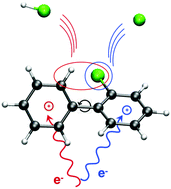The role of the dihedral angle and excited cation states in ionization and dissociation of mono-halogenated biphenyls; a combined experimental and theoretical coupled cluster study†
Abstract
We present a combined theoretical and experimental study on the ionization and primary fragmentation channels of the mono-halogenated biphenyls; 2-chlorobiphenyl, 2-bromobiphenyl and 2-iodobiphenyl. The ionization energies (IEs) of the 2-halobiphenyls and the appearance energies (AEs) of the principal fragments are determined through electron impact ionization, while quantum mechanical calculations at the coupled cluster level of theory are used to elucidate the observed processes and the associated dynamics. The primary fragmentation channels are the direct loss of the halogen upon ionization, the loss of the respective hydrogen halides (HX) as well as loss of the hydrogen halide and an additional hydrogen. We find that the dihedral angle strongly influences the relative potential energy of the neutral and the cation on their respective ground state surfaces, an effect caused by the strong influence of the nuclear motion on the conjugation between the phenyl rings. For the principal dissociative ionization channels from the mono-halogenated biphenyls we reason that these can not be described as statistical decay from the ground state cation, but must rather be understood as direct, state-selective processes from specific excited cationic states characterized through local ionization of either the halogenated or the non-substituted phenyl ring.



 Please wait while we load your content...
Please wait while we load your content...